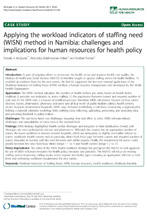
New Publication Spotlight: Applying the Workload Indicators of Staffing Need (WISN) Method in Namibia: Challenges and Implications for Human Resources for Health Policy
In countries with health workforce shortages, how can health systems close the gap between existing and required numbers of health workers? Having access to reliable workload information is an important first step. In Namibia, the Ministry of Health and Social Services wanted to update staffing norms for public-sector health facilities—ranging from large hospitals to smaller health centers and clinics. The Ministry used the Workload Indicators of Staffing Need (WISN) tool developed by the World Health Organization to establish an evidence base for the new norms. An article published in the journal Human Resources for Health describes this first-ever national application of WISN and explores some of the challenges encountered.
In Namibia, the Ministry of Health and Social Services wanted to update staffing norms for public-sector health facilities—ranging from large hospitals to smaller health centers and clinics. The Ministry used the Workload Indicators of Staffing Need (WISN) tool developed by the World Health Organization to establish an evidence base for the new norms. An article published in the journal Human Resources for Health describes this first-ever national application of WISN and explores some of the challenges encountered.
Pamela McQuide of CapacityPlus lead partner IntraHealth International is the lead author of Applying the Workload Indicators of Staffing Need (WISN) Method in Namibia: Challenges and Implications for Human Resources for Health Policy. Other authors include Riitta-Liisa Kolehmainen-Aitken, a consultant who supported the country’s WISN application, and Norbert Forster, deputy permanent secretary of the Ministry of Health and Social Services.
What does the Workload Indicators of Staffing Need tool do?
WISN calculates the number of health workers per cadre, based on the workload of a particular health facility. In Namibia, the national WISN calculations focused on four categories of health workers (doctors, nurses, pharmacists, and pharmacy assistants), relying primarily on nationally available sources of human resources information, and service statistics. Application of the WISN method in Namibia identified serious staff shortages for doctors and pharmacists, in particular. The analysis of nurse staffing showed that while the country has an appropriate number of nurses overall, the distribution of nurses is skewed toward hospitals. The WISN method also identified staffing inequities within and between regions, and variable workloads even at the same type of health facility.
Using the tool to inform policy
One of the appealing aspects of WISN is that it allows policy-makers to consider the potential impact of decisions on staff requirements before actually making the decisions. In the short term in Namibia, the Ministry is focusing on revising staffing norms, improving staffing equity across regions and types of facilities, and ensuring an appropriate skill mix at each level, including estimating workforce requirements for new cadres. McQuide says, “The national application of WISN estimates allowed the Ministry of Health and Social Services to advocate for budgeting of facility-level staff with the Ministry of Finance.” A Ministry of Finance representative commented, “With these kinds of data, I can understand why we need these staff.”
CapacityPlus’s role
CapacityPlus has been assisting the Ministry of Health and Social Services to use WISN to estimate workload requirements for doctors, nurses, and pharmacists in all 13 regions of the country.
CapacityPlus’s overall work in Namibia focuses on technical assistance to the Ministry of Health and Social Services and faith-based organizations to enhance health workforce planning, budgeting, deployment, management, and retention of the health workforce, in support of health workers’ transition from donor funding to the government payroll.
Help CapacityPlus spread the word about strengthening the health workforce. Follow us on Twitter and like us on Facebook.
Related items:


